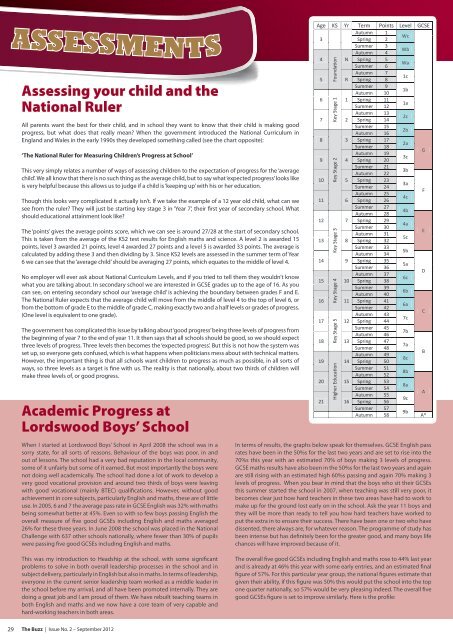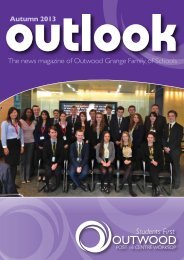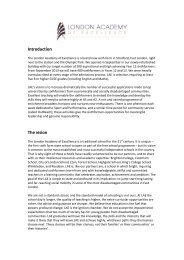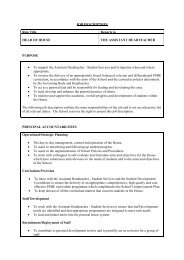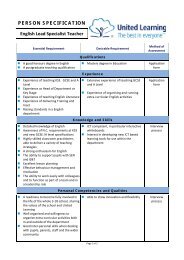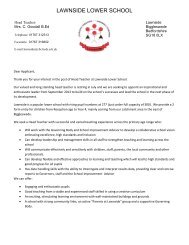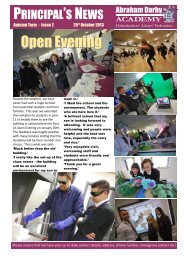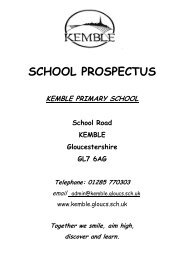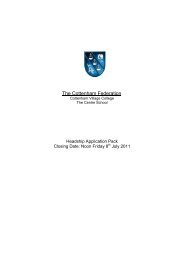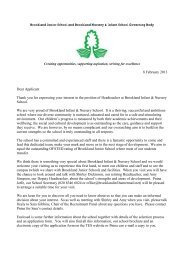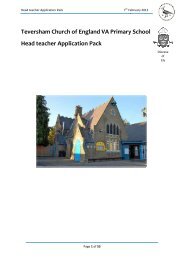INSIDE THIS EXCITING ISSUE: - The TES
INSIDE THIS EXCITING ISSUE: - The TES
INSIDE THIS EXCITING ISSUE: - The TES
Create successful ePaper yourself
Turn your PDF publications into a flip-book with our unique Google optimized e-Paper software.
Assessing your child and the National Ruler<br />
Assessing your child and the<br />
All parents want the best for their child, and in school they want<br />
to know that their child is making good progress, but what does<br />
that really mean? When the government introduced the National<br />
Curriculum in England and Wales in the late 1980s and early<br />
1990s they developed something called (see the chart opposite):<br />
‘<strong>The</strong> National Ruler for Measuring Children’s Progress at School’<br />
This very simply relates a number of ways of assessing children to<br />
the expectation of progress for the ‘average child’. We all know<br />
National Ruler<br />
that there is no such thing as the average child, but to say what<br />
‘expected progress’ looks like is very helpful because this allows<br />
All parents want the best for their child, and in school us to they judge want if a child to know is ‘keeping that up’ their with child his or is her making education. good<br />
progress, but what does that really mean? When the government introduced the National Curriculum in<br />
Though this looks very complicated it actually isn’t. If we take the<br />
England and Wales in the early 1990s they developed something called (see the chart opposite):<br />
example of a 12 year old child, what can we see from the ruler?<br />
<strong>The</strong>y will just be starting key stage 3 in ‘Year 7’, their first year of<br />
‘<strong>The</strong> National Ruler for Measuring Children’s Progress at School’<br />
secondary school. What should educational attainment look like?<br />
This very simply relates a number of ways of assessing <strong>The</strong> children ‘points’ to gives the the expectation average points of progress score, which for the we ‘average can see is<br />
child’. We all know that there is no such thing as the average around 27/28 child, at but the to start say what of secondary ‘expected school. progress’ This is looks taken like from<br />
is very helpful because this allows us to judge if a child the is average ‘keeping of up’ the with KS2 test his or results her education. for English maths and science.<br />
A level 2 is awarded 15 points, level 3 awarded 21 points, level 4<br />
Though this looks very complicated it actually isn’t. If we take the example of a 12 year old child, what can we<br />
awarded 27 points and a level 5 is awarded 33 points. <strong>The</strong><br />
see from the ruler? <strong>The</strong>y will just be starting key stage 3 in ‘Year 7’, their first year of secondary school. What<br />
average is calculated by adding these 3 and then dividing by 3.<br />
should educational attainment look like?<br />
Since KS2 levels are assessed in the summer term of Year 6 we<br />
can see that the ‘average child’ should be averaging 27 points,<br />
<strong>The</strong> ‘points’ gives the average points score, which we can see is around 27/28 at the start of secondary school.<br />
This is taken from the average of the KS2 test results<br />
which<br />
for English<br />
equates<br />
maths<br />
to the middle<br />
and science.<br />
of level<br />
A<br />
4.<br />
level 2 is awarded 15<br />
points, level 3 awarded 21 points, level 4 awarded 27 No points employer and will a level ever 5 ask is awarded about National 33 points. Curriculum <strong>The</strong> average Levels, is and<br />
calculated by adding these 3 and then dividing by 3. if Since you tried KS2 to levels tell them are assessed they wouldn’t in the know summer what term you are of Year talking<br />
6 we can see that the ‘average child’ should be averaging about. 27 In points, secondary which school equates we are to interested the middle in of GCSE level grades 4. up<br />
to the age of 16. As you can see, on entering secondary school<br />
No employer will ever ask about National Curriculum Levels, and if you tried to tell them they wouldn’t know<br />
our ‘average child’ is achieving the boundary between grades F<br />
what you are talking about. In secondary school we are interested in GCSE grades up to the age of 16. As you<br />
and E. <strong>The</strong> National Ruler expects that the average child will<br />
can see, on entering secondary school our ‘average child’ is achieving the boundary between grades F and E.<br />
move from the middle of level 4 to the top of level 6, or from the<br />
<strong>The</strong> National Ruler expects that the average child will move from the middle of level 4 to the top of level 6, or<br />
from the bottom of grade E to the middle of grade C,<br />
bottom<br />
making<br />
of<br />
exactly<br />
grade<br />
two<br />
E to the<br />
and<br />
middle<br />
a half levels<br />
of grade<br />
or<br />
C,<br />
grades<br />
making<br />
of<br />
exactly<br />
progress.<br />
two<br />
(One level is equivalent to one grade).<br />
and a half levels or grades of progress. (One level is equivalent to<br />
one grade)<br />
<strong>The</strong> government has complicated this issue by talking <strong>The</strong> about government ‘good progress’ has complicated being three this levels issue by of talking progress about from<br />
the beginning of year 7 to the end of year 11. It then<br />
‘good<br />
says that<br />
progress’<br />
all schools<br />
being<br />
should<br />
three levels<br />
be good,<br />
of progress<br />
so we<br />
from<br />
should<br />
the<br />
expect<br />
beginning<br />
three levels of progress. Three levels then becomes the ‘expected progress’. But this is not how the system was<br />
of year 7 to the end of year 11. It then says that all schools should<br />
set up, so everyone gets confused, which is what happens when politicians mess about with technical matters.<br />
be good, so we should expect three levels of progress. Three<br />
However, the important thing is that all schools want children to progress as much as possible, in all sorts of<br />
levels then becomes the ‘expected progress’. But this is not how<br />
ways, so three levels as a target is fine with us. <strong>The</strong> reality is that nationally, about two thirds of children will<br />
make three levels of, or good progress.<br />
the system was set up, so everyone gets confused, which is what<br />
happens when politicians mess about with technical matters.<br />
However, the important thing is that all schools want children to<br />
progress as much as possible, in all sorts of ways, so three levels<br />
as a target is fine with us. <strong>The</strong> reality is that nationally, about two<br />
thirds of children will make three levels of, or good progress.<br />
Academic Progress at<br />
Lordswood Boys’ School<br />
When I started at Lordswood Boys’ School in April 2008 the school was in a<br />
sorry state, for all sorts of reasons. Behaviour of the boys was poor, in and<br />
out of lessons. <strong>The</strong> school had a very bad reputation in the local community,<br />
some of it unfairly but some of it earned. But most importantly the boys were<br />
not doing well academically. <strong>The</strong> school had done a lot of work to develop a<br />
very good vocational provision and around two thirds of boys were leaving<br />
with good vocational (mainly BTEC) qualifications. However, without good<br />
achievement in core subjects, particularly English and maths, these are of little<br />
use. In 2005, 6 and 7 the average pass rate in GCSE English was 32% with maths<br />
being somewhat better at 45%. Even so with so few boys passing English the<br />
overall measure of five good GCSEs including English and maths averaged<br />
26% for these three years. In June 2008 the school was placed in the National<br />
Challenge with 637 other schools nationally, where fewer than 30% of pupils<br />
were passing five good GCSEs including English and maths.<br />
Age KS Yr Term Points Level GCSE<br />
Autumn 1<br />
3<br />
Spring 2<br />
Wc<br />
Summer 3<br />
Autumn 4<br />
Wb<br />
4 N Spring 5<br />
Summer 6<br />
Wa<br />
Autumn 7<br />
5 R Spring 8<br />
1c<br />
Summer 9<br />
Autumn 10<br />
1b<br />
6 1 Spring 11<br />
Summer 12<br />
1a<br />
Autumn 13<br />
7 2 Spring 14<br />
2c<br />
Summer 15<br />
Autumn 16<br />
2b<br />
8 3 Spring 17<br />
Summer 18<br />
2a<br />
Autumn 19<br />
9 4 Spring 20<br />
3c<br />
G<br />
Summer 21<br />
Autumn 22<br />
3b<br />
10 5 Spring 23<br />
Summer 24<br />
3a<br />
Autumn 25<br />
11 6 Spring 26<br />
4c<br />
F<br />
Summer 27<br />
Autumn 28<br />
4b<br />
12 7 Spring 29<br />
Summer 30<br />
4a<br />
Autumn 31<br />
13 8 Spring 32<br />
5c<br />
E<br />
Summer 33<br />
Autumn 34<br />
5b<br />
14 9 Spring 35<br />
Summer 36<br />
5a<br />
Autumn 37<br />
15 10 Spring 38<br />
6c<br />
D<br />
Summer 39<br />
Autumn 40<br />
6b<br />
16 11 Spring 41<br />
Summer 42<br />
6a<br />
Autumn 43<br />
17 12 Spring 44<br />
7c<br />
C<br />
Summer 45<br />
Autumn 46<br />
7b<br />
18 13 Spring 47<br />
Summer 48<br />
7a<br />
Autumn 49<br />
19 14 Spring 50<br />
8c<br />
B<br />
Summer 51<br />
Autumn 52<br />
8b<br />
20 15 Spring 53<br />
Summer 54<br />
8a<br />
Autumn 55<br />
21 16 Spring 56<br />
9c<br />
A<br />
Summer 57<br />
9b<br />
Autumn 58 A*<br />
Foundation<br />
Key Stage 1<br />
Key Stage 2<br />
Key Stage 3<br />
Key Stage 4<br />
Key Stage 5<br />
Higher Education<br />
In terms of results, the graphs below speak for themselves. GCSE English pass<br />
rates have been in the 50%s for the last two years and are set to rise into the<br />
70%s this year with an estimated 70% of boys making 3 levels of progress.<br />
GCSE maths results have also been in the 50%s for the last two years and again<br />
are still rising with an estimated high 60%s passing and again 70% making 3<br />
levels of progress. When you bear in mind that the boys who sit their GCSEs<br />
this summer started the school in 2007, when teaching was still very poor, it<br />
becomes clear just how hard teachers in these two areas have had to work to<br />
make up for the ground lost early on in the school. Ask the year 11 boys and<br />
they will be more than ready to tell you how hard teachers have worked to<br />
put the extra in to ensure their success. <strong>The</strong>re have been one or two who have<br />
dissented, there always are, for whatever reason. <strong>The</strong> programme of study has<br />
been intense but has definitely been for the greater good, and many boys life<br />
chances will have improved because of it.<br />
<strong>The</strong> Curriculum at<br />
Lordswood Boys’ School<br />
Academic Progress at Lordswood Boys’ School<br />
When I started at Lordswood Boys’ School in April 2008 the school was in a sorry state, for all sorts of reasons.<br />
Behaviour of the boys was poor, in and out of lessons. <strong>The</strong> school had a very bad reputation in the local community,<br />
some of it unfairly but some of it earned.<br />
<strong>The</strong> Curriculum<br />
But most<br />
at Lordswood<br />
importantly<br />
Boys’<br />
the<br />
School<br />
boys were not doing well academically. <strong>The</strong><br />
school had done a lot of work to develop a very good vocational provision and around two thirds of boys were<br />
<strong>The</strong> main organisational arrangements a school has to ensure that pupils get the right ‘educational diet’ are:<br />
leaving with good vocational (mainly BTEC) qualifications. However, without good achievement in core subjects,<br />
‣ <strong>The</strong> structure of the school day and week, including the number and length of lessons<br />
particularly English and maths, these are ‣ of <strong>The</strong> little amount use. of In time 2005, devoted 6 to and each 7 subject the average and options pass offered rate to in pupils GCSE as they English progress was 32%<br />
‣ <strong>The</strong> arrangements for setting (by ability) and grouping of pupils within subject areas<br />
with maths being somewhat better at 45%. Even so with so few from boys the faculty passing of reasoning English to the that of overall creative measure studies. of five<br />
good GCSEs including English and maths<br />
If these<br />
averaged<br />
are not right<br />
26%<br />
for the<br />
for<br />
pupils<br />
these<br />
this<br />
three<br />
creates<br />
years.<br />
significant<br />
In<br />
difficulties<br />
June 2008<br />
in ensuring<br />
the school<br />
consistent<br />
was<br />
progress.<br />
placed in<br />
the National Challenge with 637 other schools nationally, where fewer than 30% of pupils were passing five good<br />
GCSEs including English and maths.<br />
<strong>The</strong> main organisational arrangements a school has to ensure that pupils get computerised timetabling system to work out option blocks and the vast<br />
the right ‘educational diet’ are:<br />
majority of boys are able to study their first three choices. <strong>The</strong>y also now study<br />
• <strong>The</strong> structure of the school day and week, including the number and length a qualification in PE, which with GCSEs in English, maths, science, German and<br />
of lessons<br />
short-course RE offers a broad and balanced curriculum. We continue to make<br />
• <strong>The</strong> amount of time devoted to each subject and options offered to pupils small changes as the need arises; two subjects will move faculties this year:<br />
as they progress<br />
geography from the faculty of environment to that of social studies and ICT<br />
• <strong>The</strong> arrangements for setting (by ability) and grouping of pupils within<br />
subject areas<br />
•<br />
<strong>The</strong> charts below show how we have<br />
All core<br />
changed<br />
subject<br />
the<br />
areas<br />
structure<br />
now<br />
of<br />
have<br />
the school<br />
the freedom<br />
curriculum<br />
to set<br />
over<br />
pupils<br />
the recent<br />
according<br />
past,<br />
to<br />
to better<br />
their<br />
If these are not right for the pupils this creates significant difficulties in ensuring ability in that subject. In the past pupils were banded into bands X and Y on<br />
fit the needs of the boys. We teach subjects for 25 hours per week. This was organised into 25 one hour lessons, but<br />
consistent progress.<br />
entering the school in all subjects, meaning that they were either always in<br />
following extensive consultation in 2010, we changed to 6 fifty minute lessons per day giving 30 per week. |<strong>The</strong>se<br />
lower sets or always in higher sets, and movement between the two was very<br />
<strong>The</strong> charts This below was my show introduction how we have to changed Headship the structure<br />
are organised<br />
at the of school, the<br />
into<br />
school<br />
three double sessions,<br />
with some difficult. significant This<br />
meaning<br />
was<br />
that<br />
problems clearly<br />
practical<br />
unfair<br />
subjects<br />
to and solve the<br />
such<br />
structure<br />
as art, technology,<br />
in both of overall the timetable<br />
PE, music<br />
has<br />
and<br />
been<br />
curriculum over the recent past, to better fit the needs drama of the can boys. be scheduled We teach in one hundred altered to minute give subjects double sessions. independence It also means from that each the other, time meaning we were able that to pupils<br />
subjects leadership for 25 hours processes per week. This in the was organised school and into allocate in 25 subject one to English hour delivery, lessons, and maths particularly in year are taught 7 and 8 correctly could in English be to split the five but level ways also of instead their maths. ability of four, in meaning every In terms subject, that of they regardless have English of<br />
but following leadership, extensive everyone consultation in the in 2010, current we changed and maths<br />
senior to leadership 6 every fifty day minute of the week.<br />
team worked how <strong>The</strong> they changes<br />
as fare a elsewhere. have also intentionally offered boys much more freedom of choice:<br />
middle leader in the school before my<br />
lessons per day giving 30 per week. |<strong>The</strong>se are<br />
organised arrival, into and three all double have sessions, been promoted meaning internally. <strong>The</strong>y are doing a great job and I am proud of them. We have rebuilt<br />
that practical teaching subjects teams such in as both art, technology, English and PE, maths and we now have a core team of very capable and hard-working teachers<br />
music and drama can be scheduled in one hundred<br />
minute in double both sessions. areas. It also means that the time<br />
we were able to allocate to English and maths in<br />
year 7 and 8 could be split five ways instead of<br />
four, meaning that they have English and maths<br />
every day of the week. <strong>The</strong> changes have also<br />
intentionally offered boys much more freedom of<br />
choice:<br />
In terms of results, the graphs below speak for themselves. GCSE English pass rates have been in the 50%s for the<br />
last two years and are set to rise into the 70%s this year with an estimated 70% of boys making 3 levels of progress.<br />
GCSE maths results have also been in the 50%s for the last two years and again are still rising with an estimated high<br />
60%s passing and again 70% making 3 levels of progress. When you bear in mind that the boys who sit their GCSEs<br />
this summer started the school in 2007, when teaching was still very poor, it becomes clear just how hard teachers in<br />
these two areas have had to work to make up for the ground lost early on in the school. Ask the year 11 boys and<br />
they will be more than ready to tell you hard teachers have worked to put the extra in to ensure their success. <strong>The</strong>re<br />
have been one or two who have dissented, there always are, for whatever reason. <strong>The</strong> program of study has been<br />
intense but has definitely been for the greater good, and many boys life chances will have improved because of it.<br />
As you can see, the options structure that I inherited<br />
meant that the boys had one 4 hour and two 2 hour<br />
options. Most boys studied a BTEC in their 4 hour<br />
options, and though this was generally successful<br />
was of limited value in terms of qualifications. It<br />
also restricted the number of boys studying GCSE<br />
subjects. For the options this year as we moved to<br />
a thirty lesson week, we introduced three options<br />
at 3 fifty minute lessons each. <strong>The</strong>se are ‘open<br />
choice’ and the boys choose reserves. We use the<br />
<strong>The</strong> overall five good GCSEs including English and maths rose to 44% last year and is already at 46% this year with<br />
some early entries, and an estimated final figure of 57%. For this particular year group, the national figures estimate<br />
that given their ability, if this figure was 50% this would put the school into the top one quarter nationally, so 57%<br />
would be very pleasing indeed. <strong>The</strong> overall five good GCSEs figure is set to improve similarly. Here is the profile:<br />
As you can see, the options structure that I inherited meant that the boys had one 4 hour and two 2 hour options.<br />
Most boys studied a BTEC in their 4 hour options, and though this was generally successful was of limited value in<br />
terms of qualifications. It also restricted the number of boys studying GCSE subjects. For the options this year as we<br />
moved to a thirty lesson week, we introduced three options at 3 fifty minute lessons each. <strong>The</strong>se are ‘open choice’<br />
and the boys choose reserves. We use the computerised timetabling system to work out option blocks and the vast<br />
majority of boys are able to study their first three choices. <strong>The</strong>y also now study a qualification in PE, which with<br />
GCSEs in English, maths, science, German and short-course RE offers a broad and balanced curriculum. We continue<br />
to make small changes as the need arises; two subjects will move faculties this year: geography from the faculty of<br />
environment to that of social studies and ICT from the faculty of reasoning to that of creative studies.<br />
All core subject areas now have the freedom to set pupils according to their ability in that subject. In the past pupils<br />
were banded into bands X and Y on entering the school in all subjects, meaning that they were either always in<br />
lower sets or always in higher sets, and movement between the two was very difficult. This was clearly unfair and<br />
the structure of the timetable has been altered to give subjects independence from each other, meaning that pupils<br />
are taught correctly to the level of their ability in every subject, regardless of how they fare elsewhere.<br />
This was my introduction to Headship at the school, with some significant<br />
problems to solve in both overall leadership processes in the school and in<br />
subject delivery, particularly in English but also in maths. In terms of leadership,<br />
everyone in the current senior leadership team worked as a middle leader in<br />
the school before my arrival, and all have been promoted internally. <strong>The</strong>y are<br />
doing a great job and I am proud of them. We have rebuilt teaching teams in<br />
both English and maths and we now have a core team of very capable and<br />
hard-working teachers in both areas.<br />
<strong>The</strong> overall five good GCSEs including English and maths rose to 44% last year<br />
and is already at 46% this year with some early entries, and an estimated final<br />
figure of 57%. For this particular year group, the national figures estimate that<br />
given their ability, if this figure was 50% this would put the school into the top<br />
one quarter nationally, so 57% would be very pleasing indeed. <strong>The</strong> overall five<br />
good GCSEs figure is set to improve similarly. Here is the profile:<br />
29 <strong>The</strong> Buzz | Issue No. 2 – September 2012 <strong>The</strong> Buzz | Issue No. 2 – September 2012 30


